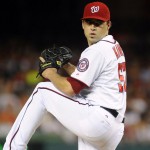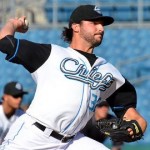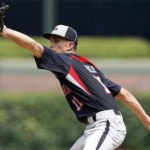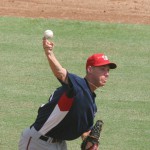This is the 3rd in the 2013 Pitching staff review series, here’s a review of Harrisburg/AA’s pitching staff for 2013. Other parts of the 2013 series: Washington/MLB’s 2013 review and Syracuse/AAA’s 2013 review.
For some historical perspective, here’s 2012’s version (featuring Danny Rosenbaum) and 2011’s version (featuring Brad Peacock) of this post specifically for Harrisburg/AA.
All stats are courtesy of either milb.com’s Harrisburg 2013 Stats page or via Fangraph’s Harrisburg Stats page. Also useful here are the Big Board and the Nats Draft Tracker.
Harrisburg starters. The rotation started the season with Broderick, Treinen, Demny, Clay and Karns. It ended with Karns, Cole, Treinen, Hill and Ray. There were quite a few changes along the way. Lets take a look at the AA starters:
- Brian Broderick got the opening day start for Harrisburg but didn’t last very long, giving the team 7 mostly bad starts before hitting the D/L. He got one more rehab start in the GCL and ended the season (I believe) on Potomac’s D/L list. It doesn’t matter; Broderick’s time with the organization is likely done after quite a whirlwind trip; he was a 2010 rule-5 draftee from St. Louis who pitched for our MLB squad for nearly two months before being jettisoned back to the Cardinals. St. Louis eventually waived him and we grabbed him in July 2012. He toiled for AA last year and started there again this year. Outlook for next season: MLFA, with another organization or perhaps out of affiliated baseball.
- Blake Treinen, aka one of the “other guys” in the Michael Morse trade, quietly put together a pretty good season for the Senators. In 21 games and 118 innings he had a 3.64 ERA and a nearly an identical 3.67 FIP. He’s not a strike out guy (86 in 118 innings for a 6.5 K/9 rate, and he gave up more base-runners than you’d like to see (1.33 whip), which is odd considering his pedigree as one of the hardest throwers in the Nats farm system. He missed a chunk of time this season with two separate D/L trips but made it back just in time to get hammered as the 4th starter in the playoffs. I projected Treinen as an eventual back-of-the-bullpen arm thanks to his velocity, but for the time being the team should want to see if he can continue to develop as a starter. Outlook for next season: back in AA as a starter, looking to push to AAA mid-season.
- Paul Demny got 15 incredibly inconsistent starts for Harrisburg this year before a D/L trip resulted in his losing his rotation spot and then eventually losing his AA spot. He ended the season in Potomac’s rotation but (likely out of respect for what the Potomac guys accomplished this year) did not participate in the High-A playoffs. AA numbers for the year: 5-6, 4.95 ERA but 86 K/s in 83+ innings. Outlook for next season: you have to think that he’s done as a starter, having failed to make the leap to AA for the second year running. I”m predicting he’s in the AA bullpen.
- Caleb Clay got 13 AA starts after signing as a MLFA before finishing the year in Syracuse. See the AAA write-up for more. Outlook for next season: in the San Francisco organization.
- Nathan Karns followed up his 2012 Nats Minor League Pitcher of the year with a dominant season at AA: 10-6 with a 3.26 ERA and 155 Ks in 132 innings. He was the first minor league reinforcement starter to get the call-up to the majors this year. (here’s my “first look” post at his 5/28/13 debut). In three MLB starts he got hit hard and was eventually returned (after an 11 day layoff) to the AA rotation. He finished the season strong and got one great playoff win, but was hammered in the season-ending championship for a sour end to a great season. Nonetheless, we saw the potential and the organization’s patience has been rewarded. For now Karns remains a starter. Outlook for next season: AAA rotation.
- Rob Gilliam ended up being the primary 6th starter/swing-man for Harrisburg this year, covering in the rotation as its original members got promoted, injured or demoted. The “forgotten man” in the big Gio Gonzalez trade, Gilliam gave the Senators 18 starts and 90 innings of 4.40 ERA ball this year. Nothing great but nothing awful; right now I see no reason to think he’s not going to serve in a similar same innings-eating role next year. Outlook for next season: AA swing-man/spot-starter.
- Taylor Hill had an exceptional season, stepping up from a guy who was throwing 5.00 ERA ball in low-A at the beginning of 2012 to a guy who was making a name for himself with sub 3.00 ERA pitching in AA by the end of 2013. He earned a promotion out of Potomac with 14 excellent starts and continued the same work in AA. His K/9 isn’t phenomenal (around 5.5 K/9 between both levels) and his FIPs show that his ERA was a bit lucky at both levels (3.38 FIP in high-A, 4.06 in AA) but the guy clearly knows how to pitch. I think he’ll be a key man in the AA rotation next year. Outlook for next season: AA rotation.
- Robbie Ray showed why I kept my faith in him despite his 6.56 ERA blow-up in Potomac in 2012. He dominated high-A in the first half of the season (10.71 K/9 in 16 High-A starts) and continued the great work as one of the youngest starters in all of AA by the time the season was over. Final AA numbers: 5-2, 3.72 ERA, 3.42 whip with 60 K’s in 58 innings. As we all know by now, Ray was the feature player in the Doug Fister acquisition and clearly made a huge impression on the Tigers GM Dave Dombrowski. I’m sorry to see him go but I’m happy with the return he brought back. Outlook for next season: in the Detroit organization.
- Taylor Jordan passed through AA during his dream 2013 season, going 7-0 with a0.83 ERA in 9 appearances. See Washington write-up for more. Outlook for next season: AAA rotation.
- A. J. Cole continued the trend of Potomac pitchers earning promotions, becoming the 5th of 5 starters who began the year in Potomac to matriculate to AA. He did not disappoint, going 4-2 with a 2.18 ERA and greater than a K/inning to solidify his status as one of the top prospects in the organization. The Michael Morse trade that engineered his return is looking better and better for the team. Outlook for next season: AA rotation to start, looking for a mid-season promotion to AAA.
- Other guys who got spot starts here and there:
- Matt Swynenberg got a few spot-starts heare and there; see the reliever section.
- Ryan Tatusko dropped down to give AA a spot start; see AAA post.
- Trevor Holder and Tyler Herron each got a spot start but were primarily relievers; see the reliever section.
Harrisburg Relievers: taking a look at the relief corps at the end of the season. We’ll start with the closers and then run down the relievers by innings pitched.
- Aaron Barrett was the primary closer for Harrisburg, earning 26 saves, striking out 69 in 50 innings and posting a 2.15 ERA. His FIP was significantly lower (1.87) thanks to an inflated BABIP for the year. Barrett’s performance on the year necessitated his protection on the 40-man roster: he was added in November ahead of the rule-5 draft. His late August injury does not seem to be that threatening; the organization clearly thinks he’s got potential to help and i’m sure he’ll feature at some point in 2014 to cover for bullpen injuries. Outlook for next season: AAA bullpen, likely the closer again.
- Tyler Herron is an interesting case: signed out of the independent leagues, he had not appeared in affiliated ball since 2009. He quickly showed he was too good for High-A and stuck around as a back of the bullpen guy in Harrisburg the rest of the season, taking over for Barrett when he hit the D/L in August. Final season stats: 6-2, 5 saves, a 3.11 ERA, and an even better FIP. Even better: 58 K’s in just 46 1/3 innings. He proved to be a very versatile arm for this team. Despite the fact that he was a MLFA signing last off-season, he’s not listed on BA’s MLFA list for this off-season; is he still with the organization? I hope so: I think he can be useful going forward. Outlook for next season: AAA bullpen, if he’s still with the org.
- Matt Swynenberg served as a longer reliever out of the bullpen and posted a 3.16 ERA in 74 innings over 36 appearances and 4 starts. He continues his steady progression up the organization but remains off the prospect-radar. He’s been rule-5 eligible two years running now and hasn’t been sniffed. He enters his last year of pre-MLFA possibly topped out in the organization thanks to a numbers game in the AAA bullpen. Outlook for next season: AA bullpen.
- Neil Holland was another big arm in the Harrisburg bullpen this year, posting 63 K’s in 50 relief innings to the tune of a 2.84 ERA/2.43 FIP. Holland was a 2010 draftee who was Rule-5 eligible this year, but he slipped through the cracks and the Nats get to keep him off the 40-man roster for one more season. He’s under-sized but has put up great numbers wherever he’s been; it is just a matter of time before he gets his shot. Outlook for next season: AA bullpen to start, with a good likelihood of moving up soon.
- Pat McCoy failed to make the jump from AA to AAA and was demoted back to Harrisburg after 7 ineffective AAA appearances. Repeating AA for the third year, he posted a 4.32 ERA in 41 middle relief innings. He exhaused his 6 years in the organization and has already signed elsewhere for 2014. Outlook for next season: in the Detroit organization.
- Matt Grace was one of NINE hurlers who earned promotions out of Potomac this year, and could be the next “sneaky good loogy” prospect that the organization develops. He transitioned away from starting after the 2011 season and has seen his numbers improve. In 38 AA innings this year he posted a 3.79 ERA but better looking 2.88 FIP. He has good control but seems hittable; his career BABIP is especially high. As with Holland, Grace passed through his first year of Rule-5 eligibility this year without any interest; he needs to push for a AAA promotion to get onto the MLB radar in 2014. Outlook for next season: AA bullpen to continue as the lefty matchup guy.
- Ian Krol exploded onto the scene for the organization, giving up just 2 earned runs in his first 21 appearances for Harrsiburg and getting a surprise call-up in June. See the MLB write-up for more. Outlook for next season: in Detroit’s organization
- Ryan Perry started the year in the AAA rotation under the National’s grand plan to make him a starter, and the experiment failed. 8 starts later, he boasted a 7.93 ERA. He hit the D/L, then was demoted to Harrisburg. There, he was outrighted off the 40-man roster and returned to the bullpen, where he was mediocre (4.43 ERA). Outlook for next season: he has to show he can get AA hitters out; you have to think he’s starting in the AA bullpen again.
- Richie Mirowski continues to impress; he has never posted an ERA above 2.61 at any level he’s appeared. Not bad for a college senior draftee from a no-name college in the 45th round who likely signed for a bonus small enough to fit into the scout’s wallet who brought him his paperwork. He posted a 1.50 ERA across 48 high-A innings and earned his promotion. For Harrisburg he had a 12.63 K/9 rate in 20 innings and posted a 1.12 FIP in a small later-season sample size. Not too shabby. Outlook for next season: AA bullpen again, looking to force another promotion.
- Pat Lehman was sent to AA after being a successful AAA guy in 2012 thanks to a numbers game; he promptly posted a 5.49ERA, got hurt and missed most of the season after just 13 appearances. He did appear in 8 rehab games in the rookie league in August but did not make it back out of Florida. Here’s the problem with Lehman; he has nothing to prove in AA; he already earned his stripes in AAA. But is there enough room for him on the AAA roster in 2014? He enters his 6th pro season and will face MLFA next year unless he pushes his way to the 40-man roster. Outlook for next season: AAA bullpen competition, a possible release candidate?
- Marcos Frias posted a 6.16 ERA in 19 innings and was dumped back to High-A. There he posted an even worse 7.59 ERA and was released mid-season. Outlook for next season: in another organization or out of baseball.
- Trevor Holder was repeating AA and had posted respectable numbers through the first month of the season when he was suddenly released to make room for Taylor Jordan‘s promotion on 5/8/13. I was shocked; we were talking about a 3rd round pick after all. He was immediately picked up by San Diego and possibly proved why the organization knows more than we do; he dropped down to high-A and was lit up in the California league (a 6.39 ERA in 100 innings). Now, its the California league (land of small ball parks and high altitudes) so the numbers are inflated (just look at what happened to A.J. Cole out there in 2012), but the story remains the same; Holder’s high draft pick was viewed at the time as the Nats “punting” on the pick to save money, and Holder never really proved anyone wrong. Outlook for next season: in San Diego’s organization.
- Michael Broadway started in Harrisburg and quickly earned a promotion to Syracuse. See the AAA writeup for more. Outlook for next season: in the Toronto organization.
- Bill Bray returned to the organization that drafted him, and returned to his “home” team; he grew up in Virginia Beach, went to William & Mary and in a bit of a personal interest item is cousins with a friend of mine; he was counting on him making the MLB team and reaping the benefits of free tickets for family and friends :-). However he struggled in the spring and was sent to minor league camp. He stuck around Viera to work on his mechanics, finally got to Harrisburg and then, after just four outings, suffered a season-ending shoulder injury. He’s a MLFA again this off-season and it remains to be seen where he picks up. I’d like to see him back here again, but Bray’s representatives have to be looking at the crowded bullpen and may suggest he continue his career elsewhere. That is if he can recover from his latest injury. To say that Bray has “unconventional” mechanics would be an understatement, and it is no shock that he’s struggled with arm issues his whole career. Outlook for next season: MLFA, in another organization.
- Other Relievers who appeared in AA of note:
- Christian Garcia pitched 4 rehab innings during his rehab tour of the organization. See AAA write-up for more.
- Ryan Mattheus pitched 4 innings of rehab over three games recovering from his broken hand. See the MLB write-up for more.
- Brian Rauh got a one-game call-up to provide bullpen cover. See the high-A write-up for more.
- Rob Wort pitched 3 AA innings before getting demoted to Potomac, where he spent the rest of the year. See the high-A write-up for more.
- Jose Lozada is normally a SS; he pitched one inning somewhere along the line in what likely was a blow-out loss.
Summary
Harrisburg got a ton of really good pitching this year, both from the starters and from the relievers. And a ton of it matriculated up over the course of the year from Potomac. Three guys on this squad jumped straight to the majors, and it isn’t hard to see another couple of these guys getting MLB debuts in 2014.






